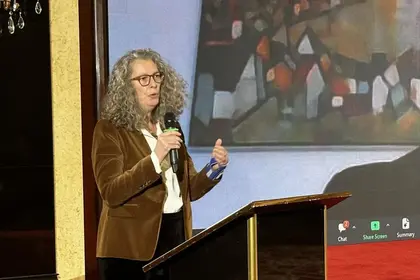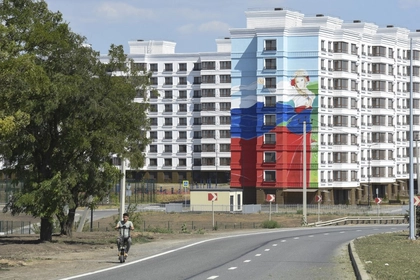From the editors: These are the remarks made by the UN's Resident Coordinator in Ukraine, Denise Brown, during the launch of the joint Rapid Damage and Needs Assessment (RDNA3) released on Feb.15, 2024 by the Government of Ukraine, the World Bank Group, the European Commission, and the United Nations.
I stood here in exact same spot last year when we launched the RDNA2, with the same actors, the Prime Minister of Ukraine, the European Union and the World Bank.
JOIN US ON TELEGRAM
Follow our coverage of the war on the @Kyivpost_official.
I was thinking this morning about what I said then, and I made the point that no one wants to live in a collective center. People want to return home, be in their communities, send their kids to school, have easy access to health care, and walk down the street to the market. And mainly live without the fear and trauma that war creates.
What I said one year ago is still true and we see it every day: Ukrainians are determined to return to their lives pre-war with their eyes on the future.
That is a big challenge for the 4.5 million internally displaced persons in Ukraine and the 5.9 million people who fled across borders to seek safety and refuge in Europe.
Missile strikes in communities along the front line and beyond, as we saw this morning, including here in Kyiv, almost every day, make that recovery a challenge. The reality is, and I see it all the time, that displacement and collective centers remain an unfortunate reality for millions of Ukrainians. Hospitals, schools, and ports continue to be attacked, damaged and destroyed.

IMF Approves $1.1 Billion Loan Disbursement to Ukraine Before Trump Inauguration
And, I think most horrifically, civilians killed, injured and maimed, including children, which is what we saw yesterday again in the Donetsk Region.
I know the RDNA3 reports it – the UN contributed, there is a great partnership with the Government, the European Union and the World Bank – and I also have what I know from my missions throughout the country that, for the moment – and it is in the report but hasn’t been mentioned yet – humanitarian assistance and recovery are going to have to co-exist for quite some time. And our challenge is linking one to the other.
Humanitarian assistance remains a lifeline for millions of Ukrainians who, because of the war, as I said many times already, can't yet go home or those who remain in their homes along the front-line communities because their life has no meaning anywhere else. And despite their daily struggles, what I heard so many times from those people is that their life has purpose, and their life has dignity, no matter how difficult it is.
I really want to emphasize that the Government, the United Nations, the international and national NGOs, local volunteers, the regional and local authorities, we have created a vast network that allow us to respond when a missile strikes a community, for the displaced to provide them with daily support, for the disabled… And in the report you will see that the number of disabled in the country has grown over 7 per cent since we launched the RDNA 2. And the support for the elderly. So that network provides this assistance.
In Bilozerka, where I was about 10 days ago, and in Kherson, where I was this past Monday, people continue to depend on that assistance. So, the reality is that, again, humanitarian assistance and recovery have to co-exist.
And I really want to thank the donors because your support allowed us collectively to provide 11 million people with assistance in 2023.
But what is that vital step beyond humanitarian assistance, where possible?
For the UN, and in the report this year, you will really see the focus is community recovery.
In Izium, in Mykolaiv, in Sumy, and outside of Kyiv in Ivankiv, the people and the authorities are now well positioned, the conditions are in place to move beyond humanitarian assistance and take back their lives.
Based on the leadership of local authorities, based on community-determined priorities, civil society engagement, the inclusion of women – not just inclusion of women but inclusion as decision-makers –, the disabled – again whose numbers have grown – and minority communities such as the Roma – I was in Uzhhorod last week and spent some time with them – so when the conditions are there, including security, recovery is taking place.
Social services have been re-established; schools built with bunkers – we heard that 90 per cent of children are registered, not necessarily attending but registered for schools –; hospitals and clinics reconstructed; roads and bridges repaired; agricultural land and critical social infrastructure demined; and small businesses reopened, and many of those small ones are women-owned.
This will have to happen community by community. And the numbers in the report, as you will hear and see when we have the presentation, are very big numbers, a little bit overwhelming.
But the restoration is really going to take place in the communities.
I was thinking about Mykolaiv. When I first was there in September 2022, there was no electricity, the water tasted like salt, and most of the people had left. I was there this past weekend, and it is a city that can be lived in now and people have returned.
The RDNA 3 is the documentation of the damage and needs that drives national prioritization and the financial mechanisms. But this year, in that report, we are also focusing on recovery and the human capital.
Behind the numbers is the critical need to ensure that Ukraine has the people with the right skills and capacity to take back their lives, and recover – across the country, not just in part of the country – what was lost.
I just want to finish by saying that the war is fought by the people of Ukraine.
The impact of the war is felt every single day by the people of Ukraine.
And the recovery of the country will depend on the people of Ukraine, with our support. And while we are not pleased that we have to have another RDNA, as Gevorg said, at least we have a document that will drive the priorities, determine the financial requirements, and allow us, all the partners, to align behind the common objectives.
Thank you very much.
You can also highlight the text and press Ctrl + Enter






